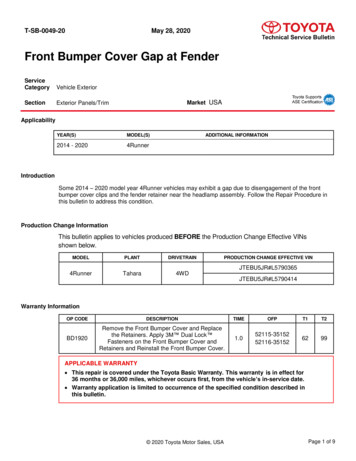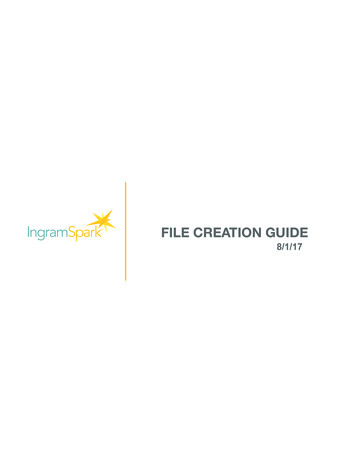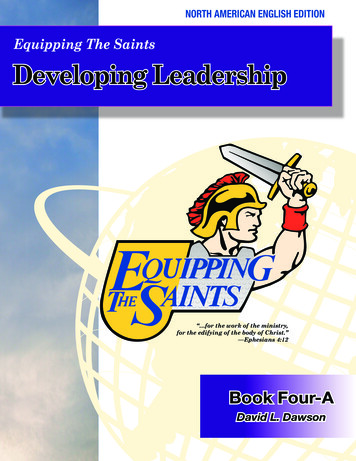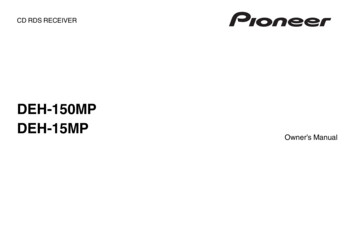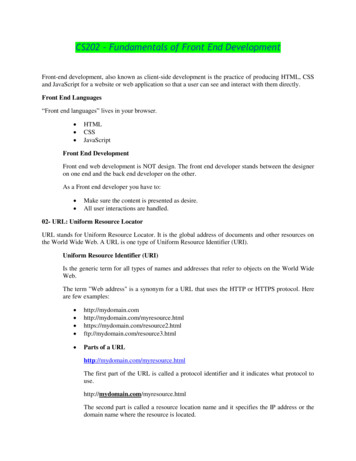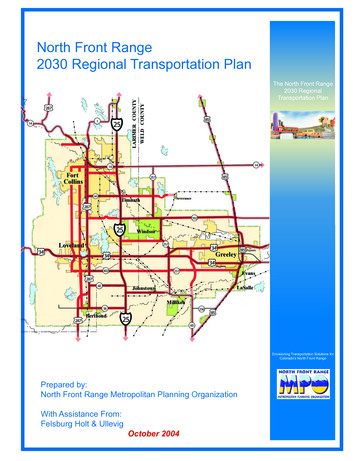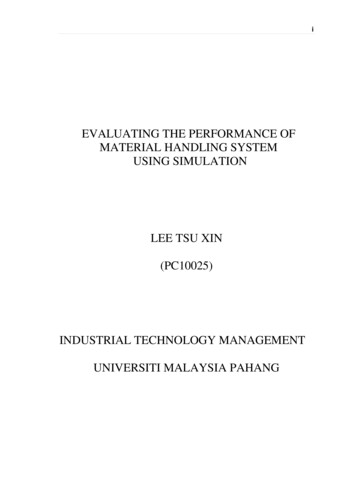
Transcription
Mursi-English-AmharicDictionaryDavid TurtonMoges Yigezu and Olisarali OlibuiDecember 2008
Culture and Art Society of Ethiopia (CASE) is a nonprofit, non-governmental Society operating in Ethiopia.The Society's mission is to document, nurture andpromote the cultural and artistic practices, naturalheritage, indigenous knowledge and socio-economicinstitutions of local communities in Ethiopia and to helpthese continue to play an active role in their lives. It iscommitted to fostering the continuation of all activitiesthat the Ethiopian people see as signifying their culturalidentity and traditional heritage. Indigenous institutionsare imbued with the wisdom needed to keep societyhealthy, both in terms of economic /material well-beingand spiritual satisfaction. They are also rich in ways ofcaring for and sustaining the environment and thelandscape. CASE is committed to studying and promotingthese traditional systems and institutions and to findingways of preserving them as living practices for posterity.The Society is therefore interested in documentingand promoting the linguistic heritage of the Ethiopianpeople, with a particular focus on the least studiedlanguages, such as that of the Mursi. It was inaccordance with this part of its mission, therefore, thatthe Society supported the production of this dictionary.CASE would like to take this opportunity to thankThe Christensen Fund, a USA based organization which
provides support for the conservation and promotion ofthe traditions and natural environment of Ethiopia.CASE also extends its sincere appreciation to Dr DavidTurton of the African Studies Centre, University ofOxford, Dr. Moges Yigezu of the Department ofLinguistics, Addis Ababa University and Ato OlisaraliOlibui, of the Mursi community, for their efforts toproduce this important work. Our appreciation also goesto the late Ba Gaha Kirinomeri, a Mursi co-researcherwho contributed significantly to the research work and,finally, to the Mursi community as a whole for preservingtheir linguistic heritage in which so much of their localindigenous knowledge is stored.CASE believes that the publication of this dictionarywill play a significant role in promoting anddocumenting the cultural knowledge of the Mursi and inencouraging forthcoming similar works.Culture andArt Society ofEthiopia
Mursi-English-AmharicDictionaryDavid TurtonMoges Yigezu andOlisarali OlibuiDecember 2008
Cover photo: Ulikoro Konyonamora (Komorakora), the Priest(Komoru) of the northern Mursi, wearing the 'gal' necklace, whichsymbolizes his office. (Photo courtesy of Ben Dome, 2004) David Turton, Moges Yigezu & Olisarali Olibui, 2008Design & Layout: Moges YigezuISBIN 978-99944-831-0-5Printed by Ermias Advertising, Addis Ababa, Ethiopia
In MemoriamGirmalugkoro (Ba Gaha) Kirinomeri(1974-2007)
PREFACEUntil about ten years ago it was still possible to describe Mursi as anentirely oral culture. In the late 1990s, however, the missionaryorganisation SIM started an informal ‘Mursi pilot education project’which proved very effective in helping a small group of Mursi, livingat Makki in the Mago valley, to read and write their own language.Perhaps the most important result of this project was the evidententhusiasm it generated for literacy, not only amongst Mursi living atMakki but also amongst those living elsewhere in Mursiland. Themain reason for the success of the project was undoubtedly that itused the students’ own language to introduce them to the practicaluses of the written word.We hope that this first dictionary of the Mursi language willhelp to satisfy the demand for literacy amongst Mursi themselves,which the SIM project so effectively demonstrated and stimulated.We offer it, first and foremost, as a modest learning aid to the Mursistudent, whether he or she is enrolled in a formal school or informaleducation centre, or working alone. But a dictionary is not just alearning aid: it is also a permanent record, however incomplete, of aparticular language and culture. We also hope, therefore, that thedictionary will help to preserve and keep alive not only the Mursilanguage but also the accumulated cultural knowledge and uniquehistorical experience of the Mursi.The shortcomings of the dictionary will be obvious to anyMursi reader. We apologise for these shortcomings but cannot stress
too strongly that we see this as the beginning of a process, rather thanas the end. The task we set ourselves when we began proved muchmore daunting than we had expected and the result falls far short ofour original aims. But if we had been more realistic, perhaps wewould not have begun at all. As it is, we hope that this first effortwill be followed by bigger and better editions in the years to come.With this in mind, we would greatly welcome the advice of readers,on any aspect of the dictionary’s content and style. Please send usyour comments and suggestions, including words and phrases(particularly up-to-date ones!) that should be added in the nextedition.It is impossible to mention all those Mursi who have, atvarious times and in various ways, contributed their time, knowledgeand expertise to the production of the dictionary. Turton isparticularly conscious of the debt he owes to countless patient andlong-suffering Mursi, many of whom are now dead, who have helpedhim to understand whatever he has been able to understand aboutMursi life, language and culture. The following, however, weredirectly involved in the production of the dictionary and shouldtherefore be especially thanked here: the late GirmalugkoroKirinomeri (whom we all knew as ‘Ba Gaha’), Ulikoro Komoru,Zinabu Bichaga and Ulikoro Dumalo. We are grateful also to AtoAlemayehu Agonafir, Colonel Endale Aberra and Major KidaneMariam Abay for their friendship, advice and support, without whichour task would have been much more difficult.The preparation of the dictionary was made possible by a grantfrom the Christensen Fund of Palo Alto, California. We thank theFund for its support and it’s Programme Officer for the SouthernRift, Dr Tadesse Wolde, for his interest, encouragement and advice.
The grant was administered by the Culture and Arts Society ofEthiopia (CASE). We thank its Director, Girma Zenebe, and hiscolleagues for their efficient and always helpful assistance and fortheir patience and understanding in the face of various delays thatheld back the completion of the manuscript.We have dedicated the dictionary to the memory of Ba Gaha, ayoung man of outstanding qualities, who died while it was still inpreparation. His tragically early death was a huge loss, not only tohis family and friends and to all those who knew and admired him,but also to the Mursi as a whole. Had he lived he would have hadmuch to contribute to helping his fellow Mursi deal with the manychanges and challenges which now confront them.David TurtonAfrican Studies CentreUniversity of Oxforddavid.turton@qeh.ox.ac.ukMoges YigezuDepartment of LinguisticsAddis Ababa Universitymoges.yigezu260@gmail.comOlisarali OlibuiMakkiSouth Omo ZoneSNNPRSolisarali.olibui1@gmail.com
INTRODUCTION1. THE PEOPLEThe Mursi live in the Lower Omo Valley of southwestern Ethiopia.They call themselves Mun (sing. Muni), and number less than10,000. Their territory of around 2,000 km2 lies in the South OmoZone of the Southern Nations, Nationalities and Peoples’ RegionalState (SNNPRS), roughly between the River Omo (known as Warr tothe Mursi) and the River Mago (known as Mako to the Mursi). Theirclosest cultural and linguistic links are with the Chai and Tirma, wholive west of the Omo and south of Maji.As we know them today, the Mursi are a relatively recentproduct of three separate population movements, each of which tookthem into territory they had not previously occupied. First there wasa move across the Omo, from the west, which may have taken placearound 150 years ago and which is seen by the Mursi as a keyhistorical event in the construction of their current political identity.Next there was an expansionary movement northwards, into betterwatered territory further up the valley, which took place in the 1920sand 1930s. Finally, beginning in 1979, there was a further expansion,this time north eastwards, into the upper Mago Valley, a move whichtook the migrants into close and regular contact with their highland1
The Mursi and their neighbours in the Lower Omo Valley2
neighbours, the plough-cultivating Aari. Each move was made,initially, by a small group of families who travelled a relatively shortdistance to a new place on the frontier of the settled area. As thepioneers established themselves, they were followed, oversucceeding years, by a drift of individuals and families. Accountsgiven of these movements by Mursi themselves always stress thatthey were a response to environmental pressures and were part of acontinuing effort to find and occupy a “cool place” (bha lalini), aplace with riverside forest for cultivation and well watered grasslandfor cattle herding.The Mursi are often described by highlanders and governmentofficials as ‘nomads’. But although cattle make a vital contribution totheir economy, they lead a relatively settled life and depend heavilyon the cultivation of grain crops, mainly sorghum and maize. Twomethods of cultivation are used. Preparations for flood-retreatcultivation begin along the banks of the Omo and Mago Rivers inOctober, when the flood waters, which reach their peak in August,have begun to recede. Sorghum, maize, cow peas, beans and tobaccoare planted in small riverbank cultivation areas, the fertility of whichis constantly renewed by the flood silts. The harvest comes inJanuary and February. Shifting cultivation takes place on highergrounds, in forest clearings further back from the two main riversand depends entirely on local rainfall. Planting takes place hereduring March and/or April, as soon as the main rains have begun,and the harvest comes in June or July. Once cleared, the same areamay be cultivated for up to six years before being left to revert tobush because of falling crop yields.Although the flood varies in extent from year to year, its timingis predictable because it depends on rain falling over the Ethiopian3
highlands. Rainfall in the Omo lowlands, however, is unpredictable,not only in amount and location but also in timing. One cannot tellexactly when, where, or for how long the rain will fall. Theunpredictability of local rainfall, and the relatively small areaavailable for flood cultivation, makes cattle products – milk, bloodand meat - a vital extra source of subsistence. Cattle can also beexchanged for grain in the nearby highlands during times of hunger,due to drought or crop pests. At such times, cattle can provide a lastdefence against starvation for many families.Although they do not depend primarily on pastoralism for theirdaily subsistence, the Mursi give overwhelming cultural importanceto cattle. Virtually every significant social relationship is based onthe exchange of cattle. This applies most obviously to marriage.Bridewealth (ideally consisting of 38 head of cattle) is handed overby the groom’s family to the bride’s father, who has to meet thedemands of a wide range of relatives, from different clans, who havea right to share in the bridewealth cattle. With each new marriage,there begins a series of cattle exchanges which continue until longafter the bride and groom are dead. Because of this, and because aman may marry several times during his life time, the institution ofbridewealth helps to ensure the continual redistribution of this vitalform of wealth, as it circulates around the population.As amongst other East African herders, adult men belong tonamed ‘age sets’ and pass through a series of ‘age grades’. Marriedwomen take their age status from their husbands. Grades areassociated with specific public tasks and responsibilities, fromlooking after and defending the herds in dry season grazing areas totaking the lead in political decision-making and the settlement ofdisputes. Leadership in public life is exercised by individual elders4
who have achieved a position of influence in the local communitythrough their oratorical and debating skills, through their knowledgeof precedent and tradition and through their reputation for wellconsidered and balanced argument. The only formally definedleadership role in the society is that of Komoru, or Priest. This is aninherited office which is principally of religious and ritualsignificance. Each major local division of the population (bhuran)has its priest, who embodies in his person the well-being of the groupas a whole and acts as a means of communication between thecommunity and God (tumwi), especially when it is threatened bysuch events as drought, crop pests and disease.Two distinctive features of Mursi society, by which they havebecome known to outsiders, are ceremonial duelling (sagine) andthe large pottery discs or ‘plates’ (debhinya) which are worn bywomen in their lower lips. Duelling is a form of martial art, in whichteams of men from different parts of the country fight each otherwith two-metre wooden poles (dongen) in short but fierce bouts,lasting no more than a few minutes. The lip-plate is an expression offemale social adulthood. A girl will often say that she wishes to haveher lip pierced in order to become like her mother – an adult womanof child bearing potential. She has her lower lip pierced, by hermother or another woman of her local community, when she reachesthe age of around fifteen. She will continue to stretch the lip, withprogressively larger wooden plugs, over the next few weeks ormonths, until she can wear a plate of up to 10 centimetres or more indiameter.The incorporation of the Mursi into the Ethiopian state beganin the last years of the nineteenth century, when the Abyssinian5
Selamago Woreda- homeland of Mursi and Bodi(Courtesy USAID: FEWS NET Activity, Regional Overview, 2006:33)Emperor Menelik II extended his control over the southern lowlandsof what is now Ethiopia. Each successive government continued tostrengthen central control over the southern periphery of the country.This has meant some increase in access to government services, suchas food aid, health and education. Meanwhile the Mursi and theirneighbours have become increasingly dependent on market exchangeto obtain not only food but also other items which, in the past fewyears, have become virtual necessities for a satisfactory lifestyle,such as plastic jerry cans, aluminum pots, cotton cloth, blankets andcommercially produced clothes.6
The pace of change for the Mursi is bound to increaserapidly during the coming years. In responding and adapting to thesechanges, the Mursi, like their neighbours, will depend above all ontheir own rich and distinctive heritage of knowledge, historicalexperience, resilience and ingenuity. This dictionary is a modesteffort to assist in the linguistic documentation of that heritage.2. THE LANGUAGEMursi is classified as a member of the Surmic group within the EastSudanic division of the Nilo-Saharan phylum (Bender 1977, Fleming1976, Dimmendaal 1998). The self-name of the people is Mun (Munisg.). Another name by which they refer to themselves but only inritual contexts and at public meetings or debates is Tama, a namealso used of them by their northern neighbors, the Bodi (whom theMursi call Tumura).Whereas much has been published on other aspects of Mursiculture and society, their language has remained largely undescribed.The only grammatical descriptions are by Turton & Bender (1976)and Turton 1981. Moges Yigezu (2001) has provided a shortphonological sketch of Mursi with a comparative wordlist of 312lexical items as part of his comparative-historical analysis of Surmiclanguages.Sound patterns of MursiVowelsMursi has a seven-vowel system like the rest of the southeast Surmiclanguages such as Bodi-Tishena, Kwegu and Chai-Tirma. The7
vowels are: i, e, E, a, O, o, and u.u All the vowels occur at allpositions within a word, i.e. word-initially, word-medially and wordfinally (see also Moges 2001).O] and [ ] are listed as allophonesThe vowels [II], [UU], [EE], [Oby Turton & Bender (1976:539) but the distribution of these vowelshas not been stated. The vowel [ ] is not attested in our data,however. In closed syllables, [ii] and [uu] are realized as [II] and [UU]respectively. Some examples: tirtir [tIrtIrtIrtIr] ‘fingernail’; murmuri tIrtIr[mUrmUrimUrmUri]mUrmUri ‘straight’.The following are some examples illustrating the contrasts betweenthe vowels phonemes:EØaaØaOØOaÎiEllEelliillekolu‘send (2sg. imp)’‘cook! (2sg. imp.)’‘go! (2sg. imp.)’‘warm’i Îo‘cloud’odZdZo ‘put! (2sg. imp.)’kolaluwaedZdZo ‘shoot! (2sg. bo8‘there are’‘call (2sg.imp.)’‘six’‘charcoal (burnedplace)’‘neck’‘preparingafence for cows’‘millet’‘village’‘milk’‘grab, take holdof’‘debt’
hali‘later’Vowel length is also apparent in Mursi but there are few contrastiveexamples attested between short and long vowels. There are,however, many words occurring with long vowels. Consider thefollowing examples:NoNoo‘neck’dirdiir‘sleeping place for young boys’‘descend (2sg.imp.)’‘clay’ aaga aga‘eat! (2sg. imp.)’tOOÎtOOÎa‘kill! (2sg.imp.)’tOÎtOÎarEE‘climb! (2sg. imp.)’‘live! (2sg. ’‘cooking pot’In contrast to Chai-Tirma, in Mursi diphthongs are very rare in thesystem.ConsonantsMursi has 22 consonant phonemes, as given in Table 1 below.Turton & Bender (1976:539) and Turton (1981:335) identified thesame consonant phonemes, but were not clear about the status of the9
glottal stop. The 22 distinct consonant phonemes are given below inIPA symbols.Table 1: Consonant phonemes of Mursibiabials talveolarspalatalsvelarsglottalstk/dgÎ sShztSdZmnlr wNjThe following are some examples illustrating the occurrence ofconsonant phonemes in the language.10
naNamagarakarratalataraÎiradiira usobassowOhu/uhunebi ebiÎi aÎija �‘stomach’‘I see’‘buy(imp.2sg)’‘taste (imp.2sg)’'to anoint’‘to sweep’‘witch craft, female’‘to be cured’‘salty soil’‘to anoint oil’‘buffalo’‘ear’‘forget’‘fill, cause to be full’‘create, reproduce’‘bald’‘kiss! (2sg. imp.)’‘cheat! (2sg. imp.)’/ojokojoNo NonoNhinihiriSuratSuradoriÎOrii oibobaribajiboÎboÎa oÎaahaaga‘rainy season’‘he travels(moves around’‘blood vein (for cows)’‘he/she’‘heart’‘man’‘to be offended’‘washing clothes’‘house’‘build (imp.2sg.)’‘uphill, above’‘look after, for cattle’‘yesterday’‘under, beneath’‘up root’‘turn over’‘things’‘cook’3. THE ORTHOGRAPHYThe Latin-based orthography presented here is primarily designed forthe transliteration of Mursi texts in order to enable the reader toreproduce the sounds of Mursi speech with reasonable accuracy. It ishoped that it might also be used for conducting literacy programs in11
this hitherto unwritten language, one of the lesser known languagesof Ethiopia.Orthographic representationVowelsThe following are the graphemes suggested for writing the vowelphonemes of Mursi.Phonemes in //u/[o][u]The only new symbols, as compared to English orthography, are the[ê] and [ô] vowels. In order to reproduce Mursi texts more accuratelyit would be useful to make distinct the more open vowels [ê] and [ô]from their closed counterparts [ee] and [o]. Vowel length is apparentin Mursi and is represented by doubling the symbol for the shortvowel.ConsonantsFor practical purposes, the consonants may be divided into twocategories. The first category consists of those sounds which aresimilar or identical to English. These are represented by using thesame symbols as in English and are given below.Phonemes in IPA SymbolsGraphemes/t/[t]12
/tStS[h][ch]/dZdZ/dZ/m//n// /[j][m][n][ny]/NN//l//r//w//j/[ng][l][r][w][y]In this first category of graphemes, the [h] grapheme is used torepresent the glottal fricative /h/, which is an independent phonemein Mursi. The same grapheme has also been used to represent anotherfeature, the palatal place of articulation, as in [ch] and [sh]. As willbe shown below, the same grapheme has been used to representimplosives as in [bh] and [dh]. Hence, the [h] grapheme is usedinconsistently representing various features. The graphemes [y] and[g] are also used in the same way, each of them representing twodifferent features. The symbol [y] represents the phoneme [j] and the13
palatal feature in [ny] while the grapheme [g] is used to represent thephoneme [g] and the velar feature in [ng].Despite these inconsistencies in the representations of somesounds, keeping the similar graphemes between Mursi and Englishwill have a pedagogical advantage if we consider the transfer ofskills students may apply in learning English as a second language.Focusing on the similarities between Mursi and Englishorthographies will, therefore, enable students to transfer their readingand writing skills in Mursi to learn English as a second language.Odlin (1989:125-126) notes that when students learn an alphabethaving some similarities with the one they have mastered, they makeinterlingual identifications of familiar letters which reduces theamount of time needed to learn to encode and decode writtensymbols.The second category consists of consonant sounds that requirenew symbols or graphemes, as follows.GraphemesPhonemes in IPA symbols////[’]/ //ÎÎ/[bh][dh]The representation of the above three sounds requires someexplanation. The representation of the glottal stop //// and theglottalized (implosive) consonants / / and /ÎÎ/ is probably the mostunfortunate feature of Latin script as observed in many Cushiticlanguages of Ethiopia such as Oromo, Sidamo, Kembatta, and manyothers. In many cases, these consonants are represented in twodifferent ways: (1) the glottal stop is represented by an apostrophe, assuggested above, and (2) the same apostrophe is used after /b/ or /d/,14
as in /b’/ and /d’/ respectively, to represent the implosives. Note thatin these languages, as in Mursi, the lengthening of consonant soundsmakes a difference of meaning. If we consider the simplex andlengthened version of the glottal stop consonant, the simplex may berepresented by an apostrophe, as shown above, while the longcounterpart has to be represented by a single quotation mark, i.e. (”).One of the consequences of this choice is that the orthography givesthe impression that the clusters ///l/, ///n/, ///m/ have the samephonological status as / / and /ÎÎ/, where /b’/ and /d’/ graphemes areused respectively. It might be confusing to differentiate between ’l,’n, ’m and b’, d’ . In the former, the apostrophe is representingthe glottal stop //// and in the latter the implosive consonant such as/ / and /ÎÎ/. This representation makes the relationship betweensimplex and geminate consonants rather opaque. Another commonpractice is to use capitals to represent the implosives but this too canbe confusing, since the use of a capital letter has a different functionin English.In order to avoid or minimize these problems, therefore, wehave decided to use a sequence of two letters, /bh/ and /dh/, torepresent the implosives, as shown above. It must be admitted,however, that the use of the apostrophe for the glottal stop may notbe the best solution, given the fact that the apostrophe is apunctuation mark.Pronunciation guideVowels[i] As in the English he /hi/[e] As in the English men /men/[ê]] As in the French cher /SER/ ‘dear, expensive’; similar to15
the English pet, but the lips are slightly further apart.[a] More or less as in English pat[ô][ ] As in the French homme /Om/ ‘man’[o] As in the French mot /mO/ ‘road’[u] As in the French route /Rut/ ‘road’Consonants[t] As in English tea /ti:/[b] ” ””bee /bi:/[d] ” ””doe /d U/[k] ” ””cap /kœp/[g] ” ””gap /gœp/[s] ” ””sip /sIp/[z] ” ””zip /zIp/[sh] ” ””ship /SIp/[h] ” ””hat /hœt/[ch] ” ””chin /tSIn/[j]” ””gin /dZIn/[m] ” ””map /mœp/[n] ” ””nap /nœp/[ny] As in Frenchvigne /vi / ‘vine’, ‘vinyard’.[ng] As in English hang �”led /led/red /red/wet /wet/yet /jet/The following symbols are used to represent sounds which are notheard in English.16
[’] represents a glottal stop.[bh] represents a bilabial implosive.[dh] represents an apical implosive.The glottal stop sound is used in some English œ/p],hœ/t],Bothimplosives,/p hat [h/t hack [hhœ/k],/k etc.bh]dh],[bhdh are produced by sucking a puff of air into the mouthbh and [dhwhile at the same time trying to say [bd] sounds respectively.b] and [dIt is helpful to think of ‘sucking with the larynx’ and produceunreleased voiced glottalic stops.4 TRANSLITERATED TEXTThe following Mursi text was taken down from Ulijeholi (Bio-itongia) Konyonomora in December 1970 and was first published inTurton (1981). It is here written in Latin-based orthography with afree English translation.How the Buma clan claimed Dirka by means of a trickZugo ojôno rôs bai chuk Jinka bhuyo. when nga irrêse ma warrinytuno. na hey na ibeThe dog put the people down behind Jinka. They moved on andcrossed the Omo upstream.Kasha; na ibe Maaji; na hey Gegolo; na hey na hey Dirkaye; nabage baa.They passed Kasha and Maji and reached Gegol. They went on toDirka and stopped there.17
Huli bage bai, Chai êl bai. na Chai whenô na Mun nise bi. nabêlêsêne môrr na chibêsêne Chai.The Chai were living there. The Chai came and the Mursi killed acow. They cut the stomach lining (peritoneum) into strips and tiedthem round the necks of the Chai.gia chibêsêne rêhi a ge.The Chai did the same to the Mursi.komoru se ke (komoru a Kônyônamôra sông‘:The Priest (the only Priest was Konyonamora) said:“Chai a gwôdinaanano, a zuaganyo; Kasha a zuaganyo;Siyoi (Dôlkamo) a zua ganyo”.“The Chai are my brothers, they are my people. The Kashaare my people; the Siyoi (of Dolkamo) are my people.”“anyi bare kêbêlêsên môrr”. Bume wheno. bêlêsên môrr. ”azuaganyo” se Kônyônamôrai.“I have cut up the stomach lining”. The Bume (Nyangatom)came. They cut up the stomach lining. “They are my people”.That is what Konyonamora said.na Bumai ibane shôgai na ôjôsêne ra tui. na ibane chalai (chalai agal, gal a komoruiny)A Bumai [clan member] took a sharpening stone and put it in the hotspring. He took a necklace (it was a ‘gal’, a priest’s necklace)na lôme ngoye.and wore it round his neck.“inye gal lômi kiong?” se Komorôr – “ani Komoru?”The priest said “why are you wearing a ‘gal’? Are you apriest?”“anyi kôlômi hung”“I am just wearing it.”18
“a galanano. na tolom na hale aino”.“It is my ‘gal’. You can wear it and then give it back to me.”môrra bag chalai na ôku kiango tui na gara.The calves swallowed the necklace and it went into their stomachsand was lost.“chalai wa gara”. Bumai se nganga. “ôku môrragwi kiangotui″.“The necklace has gone” said the Bumai. “It’s gone intoyour calves stomachs.”“na hale kêmêênêng? a barari hang hang hang. a barari.hale kêmêênêng?”“What shall I do?” said the Priest. “It is a powerfulnecklace.”Bumai ib môrra na bêl kiango, baag, gwini -. i hololoi. ôngôn gasho.The Buma opened a calf’s stomach and looked inside - it was empty.They threw it away.bel ngaina, baag, gwini – i hololoi.They opened another and looked inside - it was empty.bel ngaina, baag, gwini – i hololoi.They opened another and looked inside - it was empty.bêl ngaina – arru chalai. iba na aje ena.They opened another and saw the necklace. They gave it to the owner.Konyônamôra se ke “a bhanano”.Konyonamora said “It is my land”nông Bumai se ke “a bhanano”The Bumai said “It is my land.”“a bhanunu? inye bêmêsi ông?”19
“It is your land? What makes it yours?”“anyi bha tui ahi tinano ihe″"There is something of mine buried here”“a ông?”"What is it?"“ihe – kau rra na kôdôlaino”.“It’s there. Let’s go to the hot spring and I will show you”na hey kare. shôraana shôgai.They went together. The Bumai pulled out a sharpening stone.“ga gônya – anyi bikinging a bhanano”.“Look - it has been my land for ages”“ee - a bhanunu chirr”. Kônyônamôra se nganga. “abhanunu chirr”.“Yes, it is your land” said Konyonamora. “It is certainlyyour land”.yôk têli bai.They stayed there.ReferencesBender, Lionel M. 1977. The Surma language group: A preliminaryreport. Studies in African Linguistics Supplement 7:11–21.Dimmendaal, Gerrit, J. (ed.) (1998) Surmic Languages and Cultures,Nilo-Saharan. Linguistic Analyses and Documentation Volume 3.Köln: Rüdiger Köppe VerlagFleming, H. 1976. Omotic Overview. In In M.L. Bender (ed.), TheNon-Semitic Languages of Ethiopia, pp. 299-323, East Lansing:African Studies Center, Michigan State University. Michigan.20
Moges Yigezu (2001) A comparative study of the phonetics andphonology of Surmic languages. Ph.D thesis, Université Libre deBruxelles.Odlin. Terence (1989) Language transfer: cross-linguistic influencein language teaching. Oxford: Oxford University Press.Turton, David (1981) Le Mun (Mursi). In Jean Perrot (ed.) Leslangues dans le monde ancient et moderne, Part 1: Les langues del’Afrique subsaharienne. Paris: CNRS, pp. 335-349.Turton, David & M. Lionel Bender (1976) Mursi. In M. LionelBender (ed.) The non-Semitic languages of Ethiopia, OccasionalPapers Series, Committee on Ethiopian Studies 5. East Lancing, MI:African Studies Center, Michigan State University, pp. 553-561.21
Aabbo: antelope- ÉŸ L'¾T@Ç õ¾Mabbên antelopes- ÉŸ L ‹' ¾T@Ç õ¾KA‹achuk: meat- YÒaddanyi: hunter (Amharic borrowing) - ›Ç aênêngi: what kind is it?aga: cook- U” ›Ã’ƒ ’ ?- TwcMsabo kôgoi mai ne werio kogi tilaFirst (sabo) I’m going to the water (mai) and then I’ll cookthe porridge (tila).SËS]Á Å H H@Î Ÿ² Á Ñ”ö ›ueLLG ::agge: we (pro
Mursi-English-Amharic Dictionary David Turton Moges Yigezu and Olisarali Olibui December 2008 . Culture and Art Society of Ethiopia (CASE) is a non-profit, non-governmental Society operating in Ethiopia. The Society's mission is to document, nurture and .
